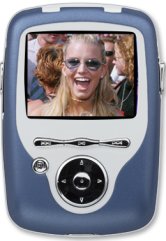

RESEARCH FROM THE INTERNATIONAL INFORMATICS
INSTITUTE
© 1995-2006 International
Informatics Institute, Inc. Some Rights Reserved.
This work is licensed under a
Creative Commons License.
Read our privacy guidelines.
Personal and mobile entertainment took off like a rocket with MP3 music players and Apple's iPod. Now, TV is getting personal with specially made video players and general purpose devices that are gaining video capabilities. And it's not just for playback but for recording and conferencing, as well.
In the last 5 years, the PDAs and mobile phones in our pockets have evolved from straight information and communications devices into increasingly cool multimedia entertainment systems. IDC figures that more than 30 million MP3 music players (both flash memory and disk-based) were sold in 2004; vendors are already preparing new video versions. ETforecasts projects that the number of multimedia-capable Windows CE and Pocket PC PDAs will reach 89 million units in 2008. Mobile phone units are difficult to count, but over half a billion phones are sold each year and the latest are sending and receiving video. And infotainment trend like wearable computing, augmented reality and WiFi TV are adding to the video signals zapped to us as we go about our daily lives.

 Portable
DVD players like the 10 inch Sony unit at right rely on an optical disk drive.
Most MP3 players use solid state memory cards that are smaller and faster than
DVDs. The next
step after MP3 music players are digital video players like this
ZVue at left (US$149.95) which uses SD
cards.
Portable
DVD players like the 10 inch Sony unit at right rely on an optical disk drive.
Most MP3 players use solid state memory cards that are smaller and faster than
DVDs. The next
step after MP3 music players are digital video players like this
ZVue at left (US$149.95) which uses SD
cards.
 Apple has
already taken a step towards video by adding digital photography
— still video — to its
latest disk-based iPod, at right. Digital video players accommodate various
formats and get their recorded content from PCs, from the Internet and
from
ripped DVDs.
Apple has
already taken a step towards video by adding digital photography
— still video — to its
latest disk-based iPod, at right. Digital video players accommodate various
formats and get their recorded content from PCs, from the Internet and
from
ripped DVDs.
Streaming video, vmail and conferencing to mobile phones like this Sony
Ericsson at left rely on the next generation 3G mobile transmission standard
like Sprint's PCS Vision in the U.S. for high speed communications. To store all
the new mobile video, a new interface standard from Hitachi and Intel will
link
Hitachi's 4 gigabyte Microdrive to mobile phones and PDAs, holding almost
a DVD's-worth of content in a 4.3 cm x 3.6 cm package.
Sprint's PCS Vision in the U.S. for high speed communications. To store all
the new mobile video, a new interface standard from Hitachi and Intel will
link
Hitachi's 4 gigabyte Microdrive to mobile phones and PDAs, holding almost
a DVD's-worth of content in a 4.3 cm x 3.6 cm package.
 Multimedia
PDAs (Personal Digital Assistants) and smartphones typically use web video
standards like Windows Media, MPEG and Quicktime to display video as large as
320 x 240 pixels.
Multimedia
PDAs (Personal Digital Assistants) and smartphones typically use web video
standards like Windows Media, MPEG and Quicktime to display video as large as
320 x 240 pixels.
 PDAs
can receive their programming by synching to a desktop PC with a multimedia
database, by wireless networking via WiFI, GPRS or 3G, or by SD card or Memory
Stick. A unique application of PDA video is augmented reality,
PDAs
can receive their programming by synching to a desktop PC with a multimedia
database, by wireless networking via WiFI, GPRS or 3G, or by SD card or Memory
Stick. A unique application of PDA video is augmented reality, overlaying text and graphics data onto real world views. The two examples at
right, linked to the IN3 Network blog, show PDA video augmented reality used
for video games and architectural visualization.
overlaying text and graphics data onto real world views. The two examples at
right, linked to the IN3 Network blog, show PDA video augmented reality used
for video games and architectural visualization.

 Augmented
reality and advanced multimedia entertainment will eventially require that the
video screen be permanently visible. Video eyeglasses used in leading edge
applications link live data and TV to the user in the operating room, the
battlefield or the shop floor. A helmet-mounted LCD, for example, feeds BMW
Formula 1 race driver Ralph Schumacher video data about his car's condition
and the course ahead.
Augmented
reality and advanced multimedia entertainment will eventially require that the
video screen be permanently visible. Video eyeglasses used in leading edge
applications link live data and TV to the user in the operating room, the
battlefield or the shop floor. A helmet-mounted LCD, for example, feeds BMW
Formula 1 race driver Ralph Schumacher video data about his car's condition
and the course ahead.
The inevitable technological and commercial evolution of mobile phones and pocket computers promises billions of new video screens worldwide in the next ten years. Faster 3G wireless telecom, pervasive WiFi networking and common SD card image standards will make it easier to get TV to the pocket. Broadcasters looking for their audiences will create new forms for the mobile viewer. The generations that depend on TV will want to carry some in their backpacks.
Gizmodo Portable Media — new products blog
Engadget Handheld — new products blog
Portable Video Player News — product reviews and PVP sales
Picturephoning — phone camera blog
Jupiter Research Personal Technologies — market research
P2PNet — peer-to-peer and digital media news
Pocket PC Thoughts — Windows Pocket PC news and reviews
ETForecast — market research
3GNewsroom — 3G news website
MobileBurn — high-end mobiledevices and Bluetooth product reviews
3G.co.uk — U.K. 3G news website
IN3's Pervasive TV Project examines the shape of the pocket video platform:
Where are the business models (e.g. advertising, location-based services, trailers, home video)?
FREE
WEBCAST
IN3's research into the
development of video culminates
with our first Pay-Per-View webcast seminar.
Five Platforms examines all the places where video lives and paints
the big picture about television's future.
Learn more or ...
See the Driving Directions for a full list of features.
WATCH THE 90
SECOND TRAILER
ON YOUTUBE.COM